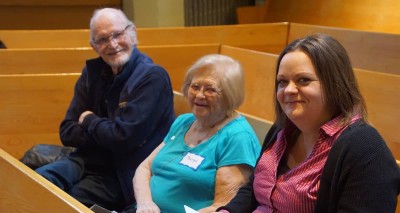Can Old and Young Worship Together?

Photo by Grace Lutheran Church (graceofapplevalley) via Flickr / CC BY 2.0 Deed
Is there hope for our aging churches? Can the older members be happy with a new, faster style of worship? Can the younger generation find hope in ancient traditions?
Can we see God in those that are different than we are? And can we let go of our prejudices and see God in those who act differently than us?
Jesus shared the following parable in Luke 5:36-39:
He also told them a parable: “No one tears a piece from a new garment and sews it on an old garment; otherwise, not only will one tear the new garment, but the piece from the new will not match the old garment. Similarly, no one puts new wine into old wineskins; otherwise, the new wine will burst the skins and will spill out, and the skins will be ruined. But new wine must be put into fresh wineskins. And no one after drinking old wine desires new wine but says, ‘The old is good.’”
After reading the parable, I wonder if it is possible for young and old to worship, work, and live together in church.
In a larger town or city with a large population base, churches can be larger, or a church can have one style of worship, focus on one segment of the population, or be big enough to have enough services to meet the needs of many different types of church members.
In small rural towns and communities, many small membership churches don’t have the resources or population to have worship services focusing on one population segment. Unfortunately, churches in those places focus on one style of worship, music, and age group, setting the church on a downward spiral, which can lead to closure.
Is there a way for old and young to learn to share different types of hymns, styles of worship, and doing church?
I believe small membership churches can become multigenerational, singing both traditional and contemporary, with worship that can blend old and new liturgy and serve both those who need pastoral care in the nursing home and hospital and those who are struggling with having the basic needs to survive.
How can we put old and new together?
First, remember that the new and contemporary hymns have the same message. The tune and language may differ, but there is nothing new about the message. The hymns speak of God’s love, forgiveness, and grace!
Second, let us remember that the liturgy of yesterday and today helps us worship God and grow as disciples of Jesus. The words may be different, but the intent is the same. Rather than get lost in the words, let us focus on the meaning and listen to how the Holy Spirit guides us in worship.
Finally, and most importantly, let us remember that we all need God, and we all need to know we are loved, forgiven, and valued. People can accept differences if they are loved and respected.
There is hope for small membership churches in small towns and communities. Growth will not come easily, but it can come when we understand that faith in God is about allowing the Holy Spirit to be with us in all our hymns, liturgy, and community.
